Exchange Currency
Ukrainian grivna
The hryvnia, sometimes hryvnya or grivna has been the national currency of Ukraine since September 2, 1996. The hryvnia is subdivided into 100 kopiyok. In medieval times, it was a currency of Kievan Rus.
Various parts of present-day Ukraine shifted between different countries in the years before World War II. Western Ukraine gained its independence from Austria on November 1, 1918, and was incorporated into Ukraine on January 22, 1919. Bukovina gained its independence from Austria on November 12, 1918, was part of Romania from December 31, 1918 until September 15, 1947 when it became part of Ukraine. Carpatho-Ukraine was part of Czechoslovakia until March 16, 1939, part of Hungary until June 29, 1945, when it was incorporated into the Ukrainian SSR. Crimea was part of the Russian SFSR, then transferred to the Ukraine in 1954.
The Ukraine declared its independence from the Soviet Union on August 24, 1991.
Russia had reformed the Ruble (RUEI) under Elizabeth II on November 23, 1755, setting 1 Gold Imperial equal to 10 Silver Rubles or 1000 Copper Kopeks. Paper Assignatzia (RUEA-Ruble-Banco) also circulated, though usually at a discount to specie money. The monetary system was reformed on July 1, 1839 with 1 Silver Ruble (RUES) set equal to 3.5 Ruble Assignatzia (RUEA). Credit Ruble Banknotes (RUEP) replaced the Ruble Assignatzia on June 1, 1843. Russia went on the Gold Standard on January 3, 1897 and introduced the Gold Ruble (RUER), which was used until the outbreak of World War I.
The Ukrainian Peoples Republic issued banknotes in 1918 denominated in Grivna (UAG) with 1 Karbovanets equal to 2 Grivna or 200 Sahib, and the Karbovanets issued at par with the Russian Ruble. After the Soviets defeated the Nationalists, the Soviet Ruble, often referred to as the Ruble Sov Nazki (RUFS), was introduced. The first currency reform occurred on January 1, 1922 when the Ruble of 1922 (RUFR) replaced the Ruble So Nazki of 1921 at 1 1922 Ruble equal to 10,000 Ruble Sonozaki. On October 22, 1922, the 1923 Ruble (SUB) replaced the 1922 Ruble at the rate of 1 1923 Ruble equal to 100 1922 Rubles. The Chervonets (SUC) was introduced on December 27, 1922, which was backed 25% by gold, and eventually replaced the Ruble Sov Nazki as a unit of account. The Gold Ruble (SUG) was introduced on March 7, 1924 equal to 1/10 Chervonetz and 50,000 Rubles of 1923.
During World War II, Germany occupied Ukraine and issued Karbowanez (UAC) banknotes from the Nazi Zentral Notenbank Ukraine. The exchange rate was set at 10 Karbowanez equal to 1 Reichsmark. The Nazis had planned on issuing banknotes in Russian in Rubles and Chervonetz, but they rejected the idea of using the Russian language on occupation banknotes. German Reichsmarks were used in the western part of Ukraine, Lei were used in the parts of Ukraine occupied by Romania, and Forints were used in Carpatho-Ukraine occupied by Hungary.
After the war, a New Ruble (SUN) replaced the Gold Ruble on December 29, 1947 at the rate of 1 New Ruble equal to 10 Gold Rubles. On January 1, 1961, the Hard Ruble (SUR) replaced the New Ruble at the rate of 1 Hard Ruble equal to 10 New Rubles.
After Ukraine gained its independence, it issued the Karbovanets (UAK) at par with the Soviet Ruble. The Hryvnia (UAH) replaced the Karbovanets on September 2, 1996 with 1 Hryvnia equal to 100,000 Karbovanets. The Hryvnia is divisible into 100 Kopiyok and is issued by the Ukrainian National Bank.
Carpatho-Ukraine, also known as Ruthenia, was the eastern part of Czechoslovakia. In March 1939, it declared its independence, but was occupied by Hungary the next day. At the end of World War II, it was reclaimed by Czechoslovakia, but was incorporated into the Ukrainian SSR as Trans-Carpathian Ukraine. No separate currency was ever issued for Carpatho-Ukraine.
Initially, the foreign exchange rate was UAH 1.76 = USD 1.00. Following the Asian financial crisis in 1998 the currency devalued to UAH 5.6 = USD 1.00 in February 2000. Later, the exchange rate remained relatively stable at around 5.4 hryvnias for 1 US dollar and was fixed to 5.05 hryvnias for 1 US dollar from 21 April 2005 until 21 May 2008. In mid-October 2008 rapid devaluation began with the hryvnia dropping 38.4% from UAH 4.85 for USD 1 on 23 September 2008 to UAH 7.88 for USD 1 on 19 December 2008. After a period of instability, a new peg of 8 hryvnias per US dollar was established, and remained for several years. In 2012, the peg was changed to a managed float (much like that of the Chinese yuan) as the euro and other European countries' currencies weakened against the dollar due to the problems in Greece, and the current value is about 8.14 hrn per dollar.
Banknotes of the first series in denominations of 50 and 100 hryven also existed but due to some reasons they were never introduced.
Also in 1996, the 1, 50, and 100 hryvnia notes of the second series were introduced, with 1 hryvnia dated 1994. The banknotes were designed and printed by British De La Rue. Since the opening of the Mint of the National Bank of Ukraine in cooperation with De La Rue in March 1994 all banknotes have been printed in Ukraine.
Later, highest denominations were added. The 200 hryvnia notes of the second series were introduced in 2001, followed by the 500 hryvnia notes of the third series in 2006.
All hryvnia banknotes issued by the National Bank continue to be a legal tender. As of 2008, the banknotes of early series can rarely be found in circulation. Also, despite the devaluing of the currency since its introduction, all kopeck coins remain in circulation, as well as all low-value hryvnia bills, including 1 hryvnia. As with the U.S. dollar, the 1 hryvnia bill is commonly used, and the 1 hryvnia coin is rarely seen. The 100 hryvnia denomination is quite common due to its moderately high value, much as with the US$20 bill.
Summary info
Summary information about Ukrainian hryvnia- ISO 4217 Code:
- UAH
- Currency sign:
- ₴
- Country:
- Ukraine
- Subunit:
- kopiyka
- Coins:
- 1 kopiyka, 2 kopiyok, 5 kopiyok, 10 kopiyok, 25 kopiyok, 50 kopiyok, 1 hryvnia
- Banknotes:
- 1 hryvnia, 2 hryvnia, 5 hryvnia, 10 hryvnia, 20 hryvnia, 50 hryvnia, 100 hryvnia, 200 hryvnia, 500 hryvnia
- Central bank:
- National Bank of Ukraine
History
Ukraine was part of the Russian Empire until the Russian Revolution. The Ukrainian Peoples Republic was founded on January 22, 1918 and remained under German influence until December 14, 1918 when Hetman P. Skoropadsky was overthrown. At the same time, a Soviet Ukrainian Peoples Republic was set up on December 25, 1917. Fighting continued between White and Red forces through 1921. The Peoples Republic was absorbed by Soviet Ukraine on May 7, 1921, and the Ukrainian Soviet Socialist Republic became a founding member of the Soviet Union on December 30, 1922.Various parts of present-day Ukraine shifted between different countries in the years before World War II. Western Ukraine gained its independence from Austria on November 1, 1918, and was incorporated into Ukraine on January 22, 1919. Bukovina gained its independence from Austria on November 12, 1918, was part of Romania from December 31, 1918 until September 15, 1947 when it became part of Ukraine. Carpatho-Ukraine was part of Czechoslovakia until March 16, 1939, part of Hungary until June 29, 1945, when it was incorporated into the Ukrainian SSR. Crimea was part of the Russian SFSR, then transferred to the Ukraine in 1954.
The Ukraine declared its independence from the Soviet Union on August 24, 1991.
Russia had reformed the Ruble (RUEI) under Elizabeth II on November 23, 1755, setting 1 Gold Imperial equal to 10 Silver Rubles or 1000 Copper Kopeks. Paper Assignatzia (RUEA-Ruble-Banco) also circulated, though usually at a discount to specie money. The monetary system was reformed on July 1, 1839 with 1 Silver Ruble (RUES) set equal to 3.5 Ruble Assignatzia (RUEA). Credit Ruble Banknotes (RUEP) replaced the Ruble Assignatzia on June 1, 1843. Russia went on the Gold Standard on January 3, 1897 and introduced the Gold Ruble (RUER), which was used until the outbreak of World War I.
The Ukrainian Peoples Republic issued banknotes in 1918 denominated in Grivna (UAG) with 1 Karbovanets equal to 2 Grivna or 200 Sahib, and the Karbovanets issued at par with the Russian Ruble. After the Soviets defeated the Nationalists, the Soviet Ruble, often referred to as the Ruble Sov Nazki (RUFS), was introduced. The first currency reform occurred on January 1, 1922 when the Ruble of 1922 (RUFR) replaced the Ruble So Nazki of 1921 at 1 1922 Ruble equal to 10,000 Ruble Sonozaki. On October 22, 1922, the 1923 Ruble (SUB) replaced the 1922 Ruble at the rate of 1 1923 Ruble equal to 100 1922 Rubles. The Chervonets (SUC) was introduced on December 27, 1922, which was backed 25% by gold, and eventually replaced the Ruble Sov Nazki as a unit of account. The Gold Ruble (SUG) was introduced on March 7, 1924 equal to 1/10 Chervonetz and 50,000 Rubles of 1923.
During World War II, Germany occupied Ukraine and issued Karbowanez (UAC) banknotes from the Nazi Zentral Notenbank Ukraine. The exchange rate was set at 10 Karbowanez equal to 1 Reichsmark. The Nazis had planned on issuing banknotes in Russian in Rubles and Chervonetz, but they rejected the idea of using the Russian language on occupation banknotes. German Reichsmarks were used in the western part of Ukraine, Lei were used in the parts of Ukraine occupied by Romania, and Forints were used in Carpatho-Ukraine occupied by Hungary.
After the war, a New Ruble (SUN) replaced the Gold Ruble on December 29, 1947 at the rate of 1 New Ruble equal to 10 Gold Rubles. On January 1, 1961, the Hard Ruble (SUR) replaced the New Ruble at the rate of 1 Hard Ruble equal to 10 New Rubles.
After Ukraine gained its independence, it issued the Karbovanets (UAK) at par with the Soviet Ruble. The Hryvnia (UAH) replaced the Karbovanets on September 2, 1996 with 1 Hryvnia equal to 100,000 Karbovanets. The Hryvnia is divisible into 100 Kopiyok and is issued by the Ukrainian National Bank.
Carpatho-Ukraine, also known as Ruthenia, was the eastern part of Czechoslovakia. In March 1939, it declared its independence, but was occupied by Hungary the next day. At the end of World War II, it was reclaimed by Czechoslovakia, but was incorporated into the Ukrainian SSR as Trans-Carpathian Ukraine. No separate currency was ever issued for Carpatho-Ukraine.
Initially, the foreign exchange rate was UAH 1.76 = USD 1.00. Following the Asian financial crisis in 1998 the currency devalued to UAH 5.6 = USD 1.00 in February 2000. Later, the exchange rate remained relatively stable at around 5.4 hryvnias for 1 US dollar and was fixed to 5.05 hryvnias for 1 US dollar from 21 April 2005 until 21 May 2008. In mid-October 2008 rapid devaluation began with the hryvnia dropping 38.4% from UAH 4.85 for USD 1 on 23 September 2008 to UAH 7.88 for USD 1 on 19 December 2008. After a period of instability, a new peg of 8 hryvnias per US dollar was established, and remained for several years. In 2012, the peg was changed to a managed float (much like that of the Chinese yuan) as the euro and other European countries' currencies weakened against the dollar due to the problems in Greece, and the current value is about 8.14 hrn per dollar.
Coins
Coins were first struck in 1992 for the new currency but were not introduced until 1996. The coins were initially produced by the Luhansk Cartridge Factory, as well as by the Italian Mint. In addition to those listed below which were released into circulation, 15 kopiyok coins were struck in both brass and aluminium.Banknotes
In 1996, the first series of hryvnia banknotes was introduced into circulation by the National Bank of Ukraine. They were dated 1992 and were in denominations of 1, 2, 5, 10 and 20 hryven’. The design of the banknotes was developed by Ukrainian artists Vasyl Lopata and Borys Maksymov. One hryvnia banknotes were printed by the Canadian Bank Note Company in 1992. Two, five and ten hryvnia banknotes were printed two years later. Until introduction into circulation the banknotes were kept in Canada.Banknotes of the first series in denominations of 50 and 100 hryven also existed but due to some reasons they were never introduced.
Also in 1996, the 1, 50, and 100 hryvnia notes of the second series were introduced, with 1 hryvnia dated 1994. The banknotes were designed and printed by British De La Rue. Since the opening of the Mint of the National Bank of Ukraine in cooperation with De La Rue in March 1994 all banknotes have been printed in Ukraine.
Later, highest denominations were added. The 200 hryvnia notes of the second series were introduced in 2001, followed by the 500 hryvnia notes of the third series in 2006.
All hryvnia banknotes issued by the National Bank continue to be a legal tender. As of 2008, the banknotes of early series can rarely be found in circulation. Also, despite the devaluing of the currency since its introduction, all kopeck coins remain in circulation, as well as all low-value hryvnia bills, including 1 hryvnia. As with the U.S. dollar, the 1 hryvnia bill is commonly used, and the 1 hryvnia coin is rarely seen. The 100 hryvnia denomination is quite common due to its moderately high value, much as with the US$20 bill.
UAH banknotes pictures gallery
| 1 Ukrainian hryvnia | |
|---|---|
| Banknote of 1 Ukrainian hryvnia has dimensions 118×63 mm and main colors are sandstorm, straw, flax, naples yellow, old gold, seashell, glaucous, lavender gray, camouflage green and desert sand. The banknote of 1 Ukrainian hryvnia was issued on the 22 May 2006. | |
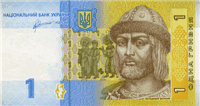 Obverse side of the 1 Ukrainian hryvnia is showing the portrait of Vladimir I of Kiev. |
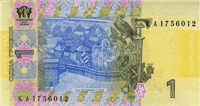 Reverse side of the 1 Ukrainian hryvnia is showing the fortress wall of Vladimir I in Kiev. |
| 2 Ukrainian hryvnia | |
|---|---|
| Banknote of 2 Ukrainian hryvnia has dimensions 118×63 mm and main colors are copper rose, light taupe, tan, pale chestnut, khaki, tea rose, shadow and beaver. The banknote of 2 Ukrainian hryvnia was issued on the 28 September 2004. | |
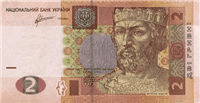 Obverse side of the 2 Ukrainian hryvnia is showing the portrait of Yaroslav the Wise. |
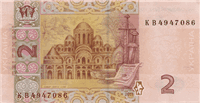 Reverse side of the 2 Ukrainian hryvnia is showing the Saint Sophia Cathedral in Kiev. |
| 5 Ukrainian hryvnia | |
|---|---|
| Banknote of 5 Ukrainian hryvnia has dimensions 118×63 mm and main colors are pale cerulean, baby blue eyes, iceberg, bubbles, pearl aqua, pale cornflower blue, lavender mist and periwinkle. The banknote of 5 Ukrainian hryvnia was issued on the 14 June 2004. | |
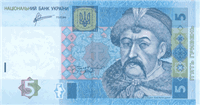 Obverse side of the 5 Ukrainian hryvnia is showing the portrait of Bohdan Khmelnytsky. |
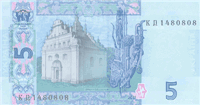 Reverse side of the 5 Ukrainian hryvnia is showing a church in the selo (village) of Subotiv. |
| 10 Ukrainian hryvnia | |
|---|---|
| Banknote of 10 Ukrainian hryvnia has dimensions 124×66 mm and main colors are seal brown, fuzzy wuzzy, tumbleweed, candy pink, dark gray, mountbatten pink, olive drab, liver and pastel pink. The banknote of 10 Ukrainian hryvnia was issued on the 1 November 2004. | |
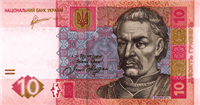 Obverse side of the 10 Ukrainian hryvnia is showing the portrait of Ivan Mazepa. |
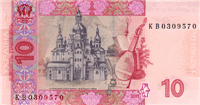 Reverse side of the 10 Ukrainian hryvnia is showing the spenski (Assumption) Cathedral in Kyiv-Pechersk Lavra Monastery, Lute, Torban, Bandura or Kobza musical instrument. |
| 20 Ukrainian hryvnia | |
|---|---|
| Banknote of 20 Ukrainian hryvnia has dimensions 130×69 mm and main colors are camouflage green, tea green, battleship grey, khaki, cambridge blue, shadow and manatee. The banknote of 20 Ukrainian hryvnia was issued on the 1 December 2003. | |
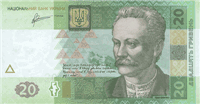 Obverse side of the 20 Ukrainian hryvnia is showing the portrait of Ivan Franko. |
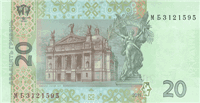 Reverse side of the 20 Ukrainian hryvnia is showing the Lviv Opera Theater. |
| 50 Ukrainian hryvnia | |
|---|---|
| Banknote of 50 Ukrainian hryvnia has dimensions 136×72 mm and main colors are thistle, bazaar, languid lavender, light mauve, periwinkle, lilac and alice blue. The banknote of 50 Ukrainian hryvnia was issued on the 5 October 2011. | |
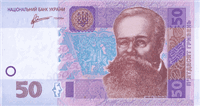 Obverse side of the 50 Ukrainian hryvnia is showing the portrait of Mykhailo Hrushevsky (1866-1934). |
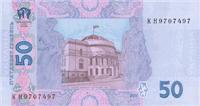 Reverse side of the 50 Ukrainian hryvnia is showing the building of the Tsentralna Rada. |
| 100 Ukrainian hryvnia | |
|---|---|
| Banknote of 100 Ukrainian hryvnia has dimensions 142×75 mm and main colors are burlywood, lemon chiffon, flax, vanilla, otter brown, old rose, pearl, pale spring bud and desert sand. The banknote of 100 Ukrainian hryvnia was issued on the 20 February 2006. | |
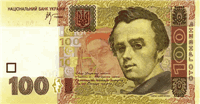 Obverse side of the 100 Ukrainian hryvnia is showing the young portrait of Taras Shevchenko. |
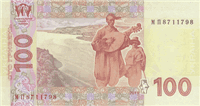 Reverse side of the 100 Ukrainian hryvnia is showing the Chernucha landscape near Cherkasy and the figures of a kobzar and a guide boy. |
| 200 Ukrainian hryvnia | |
|---|---|
| Banknote of 200 Ukrainian hryvnia has dimensions 148×75 mm and main colors are pink pearl, lavender blush, languid lavender, magnolia, classic rose, lilac, thistle, classic rose, pale aqua and glaucous. The banknote of 200 Ukrainian hryvnia was issued on the 28 May 2007. | |
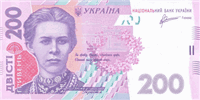 Obverse side of the 200 Ukrainian hryvnia is showing the portrait of Lesya Ukrainka. |
 Reverse side of the 200 Ukrainian hryvnia is showing the Entrance Tower of Lutsk Castle. |
| 500 Ukrainian hryvnia | |
|---|---|
| Banknote of 500 Ukrainian hryvnia has dimensions 154×75 mm and main colors are desert sand, pale pink, dark gray, pale gold, bisque, moccasin, champagne and pastel brown. The banknote of 500 Ukrainian hryvnia was issued on the 15 September 2006. | |
 Obverse side of the 500 Ukrainian hryvnia is showing the portrait of Hryhoriy Skovoroda. |
 Reverse side of the 500 Ukrainian hryvnia is showing the building of Kyiv Mohyla Academy. |
Useful links
- About National Bank of Ukraine:
- National Bank of Ukraine
- List of currencies:
- Currencies
- Security and design features of UAH banknotes:
- UAH banknotes
- UAH currency on Wikipedia:
- Ukrainian hryvnia
- Official Website of National Bank of Ukraine:
- www.bank.gov.ua
- Commemorative coins:
- Commemorative Coins